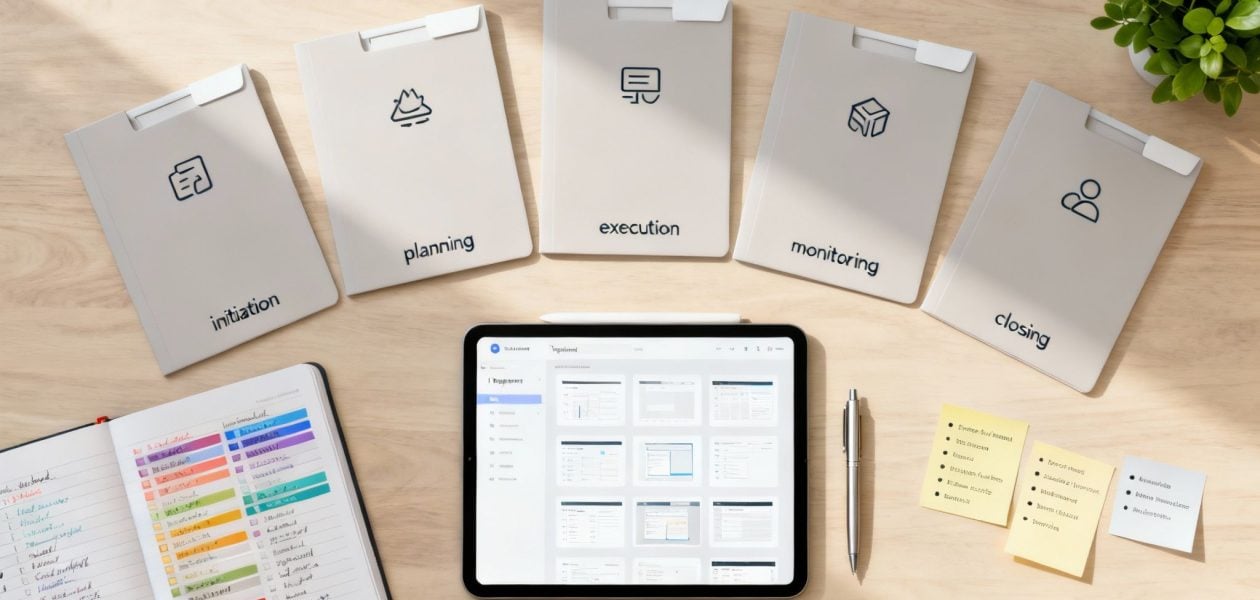Juggling deadlines, resources, and stakeholder expectations can feel like an impossible task. Projects often fail not from a lack of effort, but from a lack of structure and a failure to address critical details at the right time. Small oversights in initiation or planning can snowball into major roadblocks, leading to scope creep, budget overruns, and missed deadlines that erode profitability and client trust. This is where the systematic power of checklists comes in, transforming complex processes into manageable, repeatable steps.
This guide provides a curated roundup of 10 essential project management checklists designed to bring clarity and control to every phase of your project lifecycle. For each checklist, we provide a downloadable template, actionable implementation tips, and real-world examples specifically for agency and professional services environments. Forget generic advice; you'll gain practical tools to standardize your processes, proactively mitigate risks, and empower your teams to deliver successful projects consistently. We’ll move beyond simply listing tasks and focus on building a robust framework for predictable, high-quality outcomes. This article is your blueprint for turning project chaos into strategic control, ensuring no critical step is ever missed again. Get ready to enhance your team's efficiency and drive better results.
1. Project Initiation Checklist
A Project Initiation Checklist is the foundational document that ensures a project starts on solid ground. It serves as a comprehensive guide to verify that all essential prerequisites are defined, agreed upon, and documented before any significant resources are committed. This structured approach prevents scope creep, aligns stakeholders, and sets clear expectations from day one, making it one of the most critical project management checklists for launching a successful initiative.
This checklist typically confirms the completion of key activities such as defining the project's purpose and business case, identifying all key stakeholders and their roles, and establishing high-level objectives and success criteria.
Why This Checklist is Essential
This checklist transforms an abstract idea into a tangible, actionable project. By systematically addressing core questions upfront, you mitigate major risks that often derail projects later on, such as misaligned stakeholder expectations or an unclear business case. It provides the necessary structure to secure formal approval and creates a baseline for all future planning. For a deeper dive into this initial phase, explore our guide to creating a project management work plan to see how this checklist feeds into broader planning.
How to Implement It Effectively
- Involve All Key Stakeholders: Collaborate with the project sponsor, key team members, and primary end-users to complete the checklist. This builds early buy-in and ensures all perspectives are considered.
- Document Everything: Clearly record all decisions, assumptions, and constraints. This document becomes a crucial reference point throughout the project lifecycle.
- Hold a Formal Kickoff: Once the checklist is complete, schedule a formal kickoff meeting to present the approved project charter, introduce the team, and align everyone on the path forward.
- Iterate and Improve: Don't treat the checklist as static. Use lessons learned from previous projects to refine and update your template for future use.
2. Scope Management Checklist
A Scope Management Checklist is a project manager's essential tool for defining, validating, and controlling a project's boundaries. It ensures that the team delivers precisely what was promised, preventing the dreaded "scope creep" that can derail timelines and budgets. This checklist guides the process of documenting all project goals, deliverables, tasks, costs, and deadlines, creating a clear and agreed-upon blueprint for everyone involved.
This checklist typically includes items like creating a Work Breakdown Structure (WBS), defining project deliverables with acceptance criteria, and establishing a formal change control process. It is a critical component of any set of project management checklists, particularly for complex initiatives where requirements can easily expand.
Why This Checklist is Essential
Without a rigorous scope management process, projects are vulnerable to unauthorized changes and additions that strain resources and cause stakeholder friction. This checklist provides a structured framework to protect the project's integrity, ensuring that any modifications are formally requested, evaluated, and approved before implementation. It serves as a single source of truth for what is included-and just as importantly, what is not-in the project, aligning the team, clients, and leadership from start to finish.
How to Implement It Effectively
- Document What's Out of Scope: Explicitly list any features, tasks, or deliverables that are not part of the project. This preemptively clarifies boundaries and manages stakeholder expectations.
- Establish a Change Control Board (CCB): For larger projects, create a formal group responsible for reviewing and approving or rejecting all scope change requests. This adds a layer of governance and objective decision-making.
- Create a Visual WBS: Break down the total scope into smaller, more manageable components visually. A visual Work Breakdown Structure makes the project easier for all stakeholders to understand and helps prevent work from being overlooked.
- Secure Written Sign-Off: Never proceed with the defined scope without formal, written approval from key stakeholders, especially the project sponsor. This documented agreement is your primary defense against future scope disputes.
3. Risk Management Checklist
A Risk Management Checklist is a proactive tool used to systematically identify, assess, and plan responses to potential threats and opportunities that could impact a project. It guides teams through a structured process to ensure that risks are not overlooked, transforming risk management from a reactive, crisis-driven activity into a strategic, forward-thinking discipline. This is one of the most crucial project management checklists for safeguarding project objectives against uncertainty.
This checklist facilitates the creation of a comprehensive risk register, where potential risks are documented, analyzed for probability and impact, and assigned response strategies. It ensures a consistent approach, from identifying weather delays in construction projects to managing complex regulatory hurdles in pharmaceutical R&D.
Why This Checklist is Essential
This checklist is vital because it institutionalizes foresight. Instead of waiting for problems to arise, it forces teams to anticipate what could go wrong and prepare for it. This process minimizes negative impacts, and in some cases, turns potential threats into opportunities. For financial services projects, it could mean preemptively addressing cybersecurity threats, thereby protecting both the project and the organization's reputation. It provides a clear framework for accountability and continuous monitoring.
How to Implement It Effectively
- Involve Diverse Team Members: Conduct brainstorming sessions with a cross-functional team. Different perspectives are key to identifying a wider range of potential risks that might otherwise be missed.
- Prioritize Risks: Use a risk matrix to score each identified risk based on its potential impact and likelihood. This helps focus attention and resources on the most significant threats.
- Assign Risk Owners: Every identified risk should have a designated owner responsible for monitoring it and executing the planned response. This ensures clear accountability.
- Review and Update Regularly: The risk landscape is not static. Schedule regular reviews of the risk register, perhaps monthly or at key project milestones, to update existing risks and identify new ones.
4. Quality Assurance and Testing Checklist
A Quality Assurance and Testing Checklist is a systematic tool used to verify that project deliverables meet specified quality standards and stakeholder expectations. It guides the project team through a structured process of planning quality activities, defining acceptance criteria, executing tests, and reviewing outcomes. By standardizing the quality control process, this checklist ensures consistency, catches defects early, and validates that the final product is fit for its intended purpose.
This checklist is crucial for everything from software development, where it governs manual and automated testing cycles, to manufacturing, where Six Sigma principles are applied. It confirms that all quality-related tasks, such as peer reviews, user acceptance testing (UAT), and compliance checks, are completed thoroughly.
Why This Checklist is Essential
This checklist is the bridge between building a deliverable and delivering a successful one. It prevents the common pitfall of delivering a product that technically functions but fails to meet user needs or business requirements. Implementing a formal quality process reduces costly rework, enhances customer satisfaction, and builds confidence in the project's output. It formalizes the commitment to excellence and provides a documented trail of verification, which is often a requirement in regulated industries.
How to Implement It Effectively
- Define Acceptance Criteria Early: Work with stakeholders during the planning phase to establish clear, measurable, and testable acceptance criteria for each deliverable. This eliminates ambiguity later on.
- Create a Traceability Matrix: Link every project requirement directly to one or more test cases. This ensures that all requirements are validated and provides a clear audit trail.
- Involve End-Users in Testing: Engage actual users for User Acceptance Testing (UAT). Their feedback is invaluable for confirming that the deliverable is not just functional but also practical and user-friendly.
- Automate Where Possible: Identify repetitive testing tasks, such as regression testing, and automate them. This frees up the team to focus on more complex, exploratory testing and accelerates the feedback loop.
5. Schedule and Timeline Checklist
A Schedule and Timeline Checklist is a critical tool for mapping out a project's entire duration, ensuring all tasks are logically sequenced and realistically timed. It guides the project manager through defining activities, estimating their duration, identifying dependencies, and establishing a clear timeline from start to finish. This process is fundamental to managing resources, setting stakeholder expectations, and tracking progress against a defined baseline, making it an indispensable part of any collection of project management checklists.
This checklist validates that key scheduling activities are complete, such as developing a work breakdown structure, performing a critical path analysis, and setting milestones. It is the blueprint that dictates the pace and flow of the entire project.
Why This Checklist is Essential
This checklist provides the temporal structure every project needs. Without it, teams operate without a clear sense of priority or urgency, leading to missed deadlines and budget overruns. By meticulously planning the timeline, you can identify the most critical sequence of tasks (the critical path) and proactively manage potential bottlenecks. It transforms a list of tasks into an actionable, time-bound plan, enabling precise monitoring and control. This detailed scheduling is a cornerstone of methodologies promoted by the Project Management Institute (PMI).
How to Implement It Effectively
- Use Historical Data: Leverage data from past projects to improve the accuracy of your duration estimates. This historical context provides a realistic foundation for your timeline.
- Include Buffer Time: Always incorporate buffers or contingency time for unexpected delays. This prevents minor issues from derailing the entire project schedule.
- Focus on the Critical Path: Identify and closely monitor activities on the critical path, as any delay in these tasks will directly impact the project’s final delivery date.
- Communicate Changes Promptly: Keep all stakeholders informed of any adjustments to the timeline. Transparent communication helps manage expectations and facilitates collaborative problem-solving.
6. Budget and Cost Management Checklist
A Budget and Cost Management Checklist is a critical tool for maintaining the financial health of a project. It provides a structured framework for estimating costs, establishing a baseline budget, and controlling expenses throughout the project lifecycle. This checklist ensures that every financial decision is tracked, justified, and aligned with the project's approved funding, preventing budget overruns and providing clear financial visibility to stakeholders.
This type of checklist confirms that key financial activities are completed, such as creating detailed cost estimates, allocating funds for resources, and setting up a system for tracking actual spending against the plan. It is fundamental for any initiative where financial accountability is a priority, from IT projects using earned value management to government contracts requiring strict fiscal compliance.
Why This Checklist is Essential
This checklist provides the financial guardrails for a project, transforming abstract resource plans into a concrete budget. By systematically managing costs, you prevent the common pitfall of scope creep draining resources and ensure the project remains profitable and viable. It establishes a clear process for financial governance, making it easier to justify spending, manage stakeholder expectations, and make informed decisions when trade-offs are necessary. For a comprehensive overview of financial planning, explore our guide to project management costs.
How to Implement It Effectively
- Use Multiple Estimation Techniques: Combine methods like bottom-up, analogous, and parametric estimating to arrive at a more accurate and defensible budget.
- Include Contingency Reserves: Always allocate a portion of the budget for unforeseen risks and uncertainties. This prevents minor issues from derailing your project's finances.
- Track Costs Diligently: Implement a weekly or bi-weekly process to compare actual expenditures against the planned budget. Early detection of variances allows for timely corrective action.
- Integrate with Change Control: Ensure any change request that impacts scope, schedule, or resources is formally assessed for its effect on the budget before approval.
7. Communication and Stakeholder Management Checklist
A Communication and Stakeholder Management Checklist establishes the framework for how information flows throughout a project. It ensures that all parties, from the core team to executive sponsors and clients, receive the right information at the right time through the right channels. This systematic approach prevents misunderstandings, manages expectations, and fosters a collaborative environment where everyone feels informed and engaged.
This checklist formalizes key communication activities, such as defining stakeholder groups, outlining communication frequencies, and selecting appropriate tools. It addresses everything from daily stand-ups for distributed teams using Slack to formal weekly status reports for an executive steering committee. For any project, having a robust communication plan is a non-negotiable part of the essential project management checklists you need.
Why This Checklist is Essential
This checklist is the antidote to the most common project failure point: poor communication. By proactively planning how you will engage with stakeholders, you build trust, gain early buy-in, and can more easily navigate challenges when they arise. It transforms stakeholder management from a reactive task into a strategic function, ensuring key decision-makers remain aligned with project goals and progress, which is critical for maintaining momentum and securing resources.
How to Implement It Effectively
- Tailor Communication to the Audience: Don't use a one-size-fits-all approach. Customize the content, format, and frequency of your communication for different stakeholder groups (e.g., a high-level dashboard for executives, detailed updates for the technical team).
- Establish Clear Channels and Cadence: Define which tools to use for specific purposes (e.g., email for formal decisions, chat for quick questions) and set a predictable schedule for updates, like weekly status meetings or bi-weekly newsletters.
- Document and Distribute Key Decisions: After any significant meeting, promptly document all decisions, action items, and owners. Share this summary with all relevant stakeholders to ensure universal alignment and accountability.
- Schedule Regular Feedback Sessions: Actively solicit feedback from stakeholders on both the project's progress and the communication process itself. This helps you adapt your strategy and keeps them invested in the project's success.
8. Resource Planning and Allocation Checklist
A Resource Planning and Allocation Checklist ensures that a project has the right people, equipment, and budget available at the right time. It is a systematic tool used to identify, schedule, and assign all necessary resources, preventing bottlenecks, over-allocation, and last-minute scrambles. This structured process is vital for maintaining project velocity and staying within budget, making it one of the most practical project management checklists for operational success.
This checklist guides a project manager through confirming resource availability, assigning specific tasks to team members, scheduling equipment usage, and allocating funds. It is particularly crucial in environments like professional services firms managing consultant workloads or matrix organizations where resources are shared across multiple projects.
Why This Checklist is Essential
This checklist provides the visibility needed to manage constraints and prevent resource conflicts before they derail a project. By methodically planning resource needs, you can optimize utilization rates, ensure fairness in workload distribution, and provide functional managers with clear forecasts. It transforms resource management from a reactive, often chaotic process into a proactive, strategic function that directly supports project goals. To build a robust framework, see our guide on creating a project management resource plan and how it integrates with this checklist.
How to Implement It Effectively
- Be Proactive: Complete this checklist during the planning phase, well before execution begins, to identify potential shortfalls and secure commitments early.
- Use Centralized Tools: Employ resource management software for a real-time, single source of truth on availability and allocation. This helps avoid conflicts in dynamic environments.
- Build a Buffer: Always plan for contingencies. Allocate a small buffer for time and budget to handle unexpected resource needs or team member absences.
- Communicate Constantly: Hold regular check-ins with functional managers and the project team to review utilization rates, discuss upcoming needs, and adjust the plan as required.
9. Project Closure and Lessons Learned Checklist
A Project Closure and Lessons Learned Checklist is a critical tool for formally concluding a project and capturing valuable organizational knowledge. It provides a systematic process to ensure that all deliverables are complete, stakeholders are satisfied, and crucial insights from the project's successes and failures are documented for future use. This structured wrap-up prevents loose ends and transforms project experiences into institutional wisdom, making it one of the most forward-looking project management checklists.
This checklist guides teams through final activities like obtaining formal client acceptance, releasing project resources, archiving documentation, and conducting a post-mortem or lessons learned session. It confirms that the project has met its objectives and that the organization benefits from the experience.
Why This Checklist is Essential
This checklist ensures a project doesn't just end; it concludes professionally and strategically. By formalizing the closure, you confirm that all contractual obligations have been met, which is crucial in client-facing agencies. More importantly, the lessons learned component is the engine for continuous improvement. It helps your organization avoid repeating mistakes and replicate successes, leading to more efficient and effective project execution over time. For example, a construction firm can use it to refine its punch-list process, while an IT agency can improve future software implementations based on a formal Post-Implementation Review (PIR).
How to Implement It Effectively
- Schedule Closure Early: Plan for closure activities well before the final deadline. This ensures the team has the bandwidth to properly document outcomes without being rushed.
- Conduct Timely Lessons Learned Meetings: Hold the review session while the project experience is still fresh in everyone’s minds to capture the most accurate and detailed feedback.
- Document Both Wins and Losses: Create a balanced record of what went right and what went wrong. Analyzing successes is just as important as understanding failures.
- Archive Everything Centrally: Store all final project documents, from contracts to final reports and lessons learned, in a centralized, accessible repository for future reference.
10. Change Control and Impact Management Checklist
A Change Control and Impact Management Checklist provides a structured process for evaluating, approving, and implementing project changes. It is a critical governance tool that prevents uncontrolled scope creep while allowing the project to adapt to legitimate new requirements or external factors. This formal process ensures that every proposed change is assessed for its impact on scope, schedule, budget, and quality before a decision is made.
This checklist guides a project manager through logging the change request, analyzing its impact, presenting it to a change control board (CCB), and, if approved, integrating it into the project plan. This methodical approach is vital in environments like government contracts or large-scale construction projects where modifications require rigorous oversight.
Why This Checklist is Essential
Without a formal change control process, projects are vulnerable to scope creep, where small, unapproved changes accumulate and derail the original objectives. This checklist establishes a clear, transparent, and authoritative system for managing change. It protects the project's baseline, ensures stakeholders understand the consequences of their requests, and maintains alignment between the project team and sponsors. It turns potential chaos into a controlled, manageable evolution of the project scope.
How to Implement It Effectively
- Establish a Change Control Board (CCB): Create a formal body with the authority to approve or reject change requests. This group should include key stakeholders like the project sponsor, client representatives, and technical leads.
- Categorize Changes by Impact: Not all changes are equal. Classify them by impact level (e.g., low, medium, high) to apply a proportionate level of review. A minor text change shouldn't require the same scrutiny as a request to add a major feature.
- Require a Business Case: For significant changes, mandate that the requestor submit a business case detailing the justification, benefits, and ROI. This forces a strategic evaluation rather than an emotional one.
- Communicate All Decisions: Whether a change is approved or rejected, formally communicate the decision and the rationale to all relevant stakeholders. This transparency builds trust and manages expectations.
Comparison of 10 Project Management Checklists
| Checklist | 🔄 Implementation complexity | ⚡ Resource & effort | ⭐📊 Expected outcomes / Impact | 💡 Ideal use cases | ⭐ Key advantages |
|---|---|---|---|---|---|
| Project Initiation Checklist | Low–Medium; structured setup and stakeholder input required | Low initial effort but needs stakeholder time | Clear scope and aligned expectations; fewer surprises 📊 | Any project start, construction, SDLC | Prevents scope creep; saves time/money |
| Scope Management Checklist | Medium–High; requires WBS and formal controls | Moderate; detailed documentation and change process | Controlled deliverables and improved schedule/budget accuracy 📊 | Contracts, enterprise implementations, regulated projects | Prevents unauthorized changes; clarifies boundaries |
| Risk Management Checklist | Medium–High; analysis and ongoing monitoring | High; qualitative/quantitative analysis and owner assignments | Reduced delays/costs; contingency readiness 📊 | Construction, pharma R&D, finance/cybersecurity | Proactive mitigation; increases stakeholder confidence |
| Quality Assurance and Testing Checklist | Medium; requires QA planning and test design | High; specialized skills, tools, and test execution | Higher quality outputs; fewer defects and rework 📊 | Software, manufacturing, healthcare compliance | Early defect detection; objective quality evidence |
| Schedule and Timeline Checklist | Medium; sequencing, CPM, and baseline control | Moderate; estimation and continuous tracking | Clear timeline visibility; identifies critical tasks 📊 | Construction CPM, software releases, event planning | Realistic deadlines; improves resource coordination |
| Budget and Cost Management Checklist | Medium; estimation, EVM, variance analysis | Moderate–High; continuous financial tracking | Cost control and ROI visibility; fewer overruns 📊 | IT projects, engineering, government contracts | Prevents overruns; financial accountability |
| Communication & Stakeholder Management Checklist | Low–Medium; needs tailored plans and governance | Moderate; ongoing communications and reporting | Better alignment and faster issue resolution 📊 | Enterprise projects, distributed teams, client-facing work | Builds trust; reduces miscommunication |
| Resource Planning & Allocation Checklist | Medium; leveling, capacity planning, skill assessment | High; resource tools and ongoing adjustments | Optimal utilization; reduced overallocation/burnout 📊 | Professional services, matrix organizations, manufacturing | Maximizes efficiency; identifies skill gaps |
| Project Closure & Lessons Learned Checklist | Low–Medium; formal closeout and reviews | Low–Moderate; time for evaluations and documentation | Formal acceptance, captured lessons, ROI measurement 📊 | All projects needing continuous improvement | Ensures proper closeout; preserves knowledge |
| Change Control & Impact Management Checklist | Medium–High; workflows, impact analysis, approvals | Moderate; change boards and documentation | Controlled changes; maintained schedule/budget baselines 📊 | Software with CABs, government/regulatory projects | Balances flexibility with control; informed decisions |
Integrate Checklists into Your Workflow for Maximum Impact
Throughout this guide, we've explored ten essential project management checklists, from initiating a project and defining its scope to managing risk, controlling change, and executing a formal closure. These are not merely administrative tools; they are strategic assets designed to bring predictability, clarity, and consistency to your operations. Each checklist serves as a structured framework, ensuring no critical step is overlooked and that every team member understands their role and responsibilities.
By implementing these checklists, you transition from a reactive management style to a proactive one. Instead of fighting fires related to scope creep, budget overruns, or missed deadlines, you'll be equipped to anticipate these challenges and mitigate them before they derail your projects. The real value emerges when you view these tools not as isolated documents but as an interconnected system that supports the entire project lifecycle.
From Theory to Tangible Results
Adopting these project management checklists is the first step. The true transformation happens when you embed them into your team's daily habits and operational DNA. This cultural shift from ad-hoc processes to structured execution is what separates consistently successful agencies from those struggling with inefficiency and reporting overhead.
Here’s how to make that transition seamless and impactful:
- Start Small, Scale Smart: Don't overwhelm your team by introducing all ten checklists at once. Identify your most pressing pain points. Is scope management a constant battle? Start with the Scope Management Checklist. Are your project post-mortems ineffective? Implement the Project Closure and Lessons Learned Checklist first.
- Customize and Collaborate: The templates provided are a starting point. Your agency is unique, and your checklists should reflect that. Involve your team in adapting these tools to fit your specific workflows, client types, and project complexities. This collaborative approach fosters ownership and increases adoption rates.
- Connect Checklists to Automation: The most significant leap in efficiency comes from bridging the gap between manual checks and automated data collection. Your checklists for budget, schedule, and resource management are only as good as the data feeding them. Manually tracking time and progress is prone to error and creates the very administrative fatigue you’re trying to eliminate.
Key Insight: The ultimate goal is not just to use checklists, but to create a system where the checklist guides the work, and automated tools provide the data needed to validate each step. This creates a powerful feedback loop for continuous improvement and accurate reporting.
By combining the structured discipline of project management checklists with intelligent automation, you move beyond simple task completion. You begin to build a strategic operational framework that drives profitability, enhances client satisfaction, and empowers your team to deliver exceptional results with confidence and consistency. This integrated approach transforms checklists from a simple to-do list into a powerful engine for predictable success.
Ready to eliminate manual timesheet entry and gain real-time visibility into your team's utilization? TimeTackle automates time tracking directly from your team's calendar events, providing the accurate data you need to power your schedule, budget, and resource planning checklists. Discover how TimeTackle can streamline your project reporting today.






